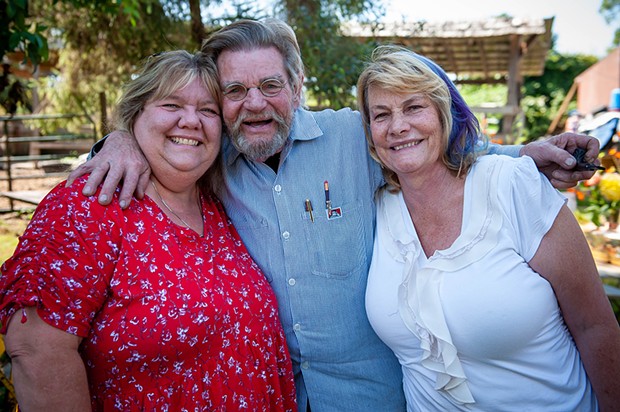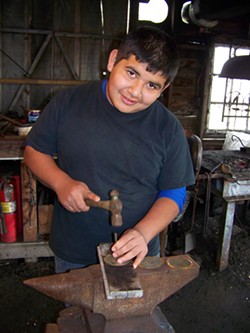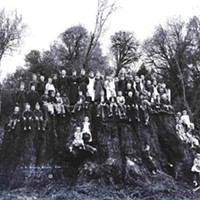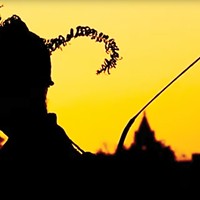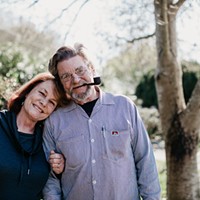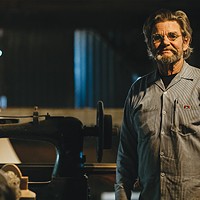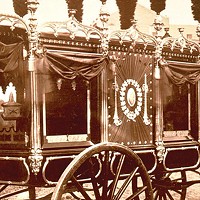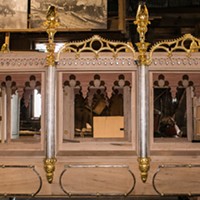Coming Full Circle
As one door closes, another opens at the Blue Ox
By Kimberly Wear [email protected] @kimberly_wear[
{
"name": "Top Stories Video Pair",
"insertPoint": "7",
"component": "17087298",
"parentWrapperClass": "fdn-ads-inline-content-block",
"requiredCountToDisplay": "1"
}
]
Jose Pacheco was a cherubic 12 year old with a troubled past and an uncertain future when he arrived at Blue Ox Community School's doorstep eight years ago.
Not even a teenager, he was already at a crossroads in life.
"I remember how scared I was because the old building had barbed wire around it," he says.
But once inside, Pacheco says he found "awesome" teachers who took him under their wings and a place where he could belong — a feeling that remains to this day.
He wasn't the only one.
Over the course of nearly two decades, the school — anchored by Blue Ox Millworks and Historic Park co-founders Eric and Viviana Hollenbeck — embraced students like Pacheco, many of whom faced immense adversity in their paths to the school's doors.
Facing those challenges can make a typical classroom setting tough to navigate, with poor attendance, learning difficulties, disruptive behavior or just falling behind in school almost inevitable outcomes — something many school systems are just beginning to actively address.
Eric Hollenbeck says he understood the kids who found their way into his workshop because he was one of them. He never fit in at school either and it wasn't until he made his way into the woods that he found his calling. Then came the Vietnam War.
After enduring some of the conflict's most intense fighting while deployed on front lines in the jungle for nearly a year straight, Eric Hollenbeck came back changed. He was 19, not much older than many of his students.
It was at the Blue Ox that he slowly began to find his way back. After buying the sprawling property in 1972 with a $300 bank loan, Eric Hollenbeck transformed a morass of muck and mud into an oasis on the bay with towering trees, a historic park and a Victorian millworks known around the world for its authentic craftmanship.
Eric Hollenbeck operates on the belief that everyone may be born with a handicap but they are also gifted with a compensator, something they're good at. The trick he tried to teach his students, he says, was to find their compensator.
"Don't beat yourself up over what you're not good at," Eric Hollenbeck says.
Together with a dedicated team of teachers, the Hollenbecks built a program unlike any other. It wove the traditional arts and a love of craftmanship into a hands-on academic curriculum, all while remaining rooted in a simple guiding principle: Ensure each student has a safe space to learn and heal.
While Pacheco didn't quite realize it at first, the Blue Ox would be among the most defining experiences of his life, one that would ultimately bring him full circle, even if the path he traveled to get there wasn't always straight or narrow.
Like many of his classmates, Pacheco's upbringing was marked by hardship; he was raised in what he describes as a "family of street violence" with little parental support.
But Pacheco credits the days he spent walking across the abandoned railroad tracks into the sanctum of the Blue Ox's X Street property as a major turning point that ultimately allowed him to break free from his family's cycle of trauma.
"I've thought about where I'd be if I hadn't had the opportunity to learn woodworking here," Pacheco says, sitting under a canopy of trees during the school's recent 20th anniversary reunion. "It trips me out that it has been eight years. I feel like that 12 year old when I come here."
As a slight breeze floated across the garden area dotted with picnic tables and chairs, Pacheco wasn't the only one reminiscing.
Amid the catching up and walks down memory lane, there was a hint of wistfulness as several former staffers swapped stories over old yearbooks their students had painstakingly crafted using lead type and an antique printing press.
Somehow, they say, a series of serendipitous events brought the right group of people together at the right time to help guide a special coterie of students through rocky times, giving them the freedom to be themselves and the space to see they each held the ability to succeed.
"It was a real home environment where (students) didn't feel judged," says retired teacher Don Hoch, who co-founded the school with the Hollenbecks in 1999 after taking a field trip to the Blue Ox with his daughter. "They felt they had the opportunity to explore. ... Kids who hadn't had success in that area of life were given an opportunity to shine in ways they hadn't been able to before."
And for many of them, that made all of the difference.
Debbie Holton, who taught with Hoch in the early days of the program, says sometimes it could take a year for students to trust them.
Once they did, the emotional walls they'd built in self-protection would begin to wear away. Then, she said, the learning and the recovery could begin.
What the staff was intuitively doing is now more widely known as "trauma informed practices," which is essentially acknowledging the emotional impacts that unstable circumstances can have on children — whether that means living with an abusive parent or facing homelessness.
The idea is to help students develop coping mechanisms by assisting them in establishing a sense of control in their lives, while also providing a caring setting in which they can let their guard down.
"That's what we were doing all along, we just didn't have a name for it," Holton says, "It was an amazing time. I was very fortunate to be a part of it."
At the Blue Ox, students discovered they could not only craft wood pens, ceramic bowls and iron fireplace tools with their own two hands, but that those creations had value to other people.
"My favorite part was when they realized they had a gift," Holton says. "It made me cry every time."
But with nearly two decades of state budget constraints taking a heavy toll on the Hollenbecks' ability to subsidize the community school program, the decision was made last year to change course.
While a handful of county office of education students are still taking classes using grant funding, the main program has been revamped to include a partnership with area charter schools and the chance for anyone in the community — children and adults — to take part in two-hour classes or four-week sessions on everything from blacksmithing to woodturning to ceramics.
For Viviana Hollenbeck, the transition is "bittersweet."
When the school began, an unusual bond was forged in the way the group of 25 or so students gathered together in one classroom each morning before spending their afternoons at the Blue Ox, many earning their diplomas from the school in the process.
In that setting, the younger students looked up to the older students, who in turn mentored them, just as they had been mentored.
"The thing that was the most special was when you would feel that connection," she says. "When you knew that they knew that we were all in this together. ... There was none of that posing that this age typically does."
Things changed a bit after the budget ax fell on Humboldt County's community school system in the wake of the recession. In 2012, the Blue Ox program lost its individual campus, meaning its students were often separated during courses at the county's Educational Resource Center site, although they continued to come to the grounds each day.
Now, the Blue Ox's students will be enrolled in charter schools — mainly in independent study programs — and come to take elective courses in five-week sessions rather than on a continuous basis all year. And instead of a consistent cohort of 25, nearly 90 students went to sessions last year.
But at least one thing hasn't changed, Eric Hollenbeck notes, saying students are still finding their way to Blue Ox and "hanging out," even when they're not in class.
Viviana Hollenbeck says opening the Blue Ox's doors wider will give more people the opportunity to experience the fulfillment that comes with the creative process.
As an example, she tells the story of a family that was visiting from out of town recently and attended a private workshop that hadn't been offered before. At the end, each family member walked out with a wooden pen they hand-turned themselves on the millwork's lathes.
As they left, Viviana Hollenbeck says, one of the parents remarked that out of all their vacations, "This was going to be the one that everyone remembered."
"There's something magical about makings things with your own hands," she notes.
Now, the Hollenbecks say, the Blue Ox will be able to expand its ability to promote the artisanal knowledge of the past and share the intrinsic pride that comes with making something that's not only beautiful, but also useful and able to stand the test of time.
The couple and their daughters Cara and Dayl — who are now stepping into more extensive roles in the family's craftmanship legacy — say it is becoming an increasingly important lesson to impart in a progressively disposable world.
But all of the passion and tireless devotion the Hollenbecks have poured into the Blue Ox over the years has not come without a price.
Bearing the brunt of their unwavering dedication to helping others — even though it meant rarely having a day off and often putting their personal lives on hold — was the couple's millworks business, which covered the overhead costs of the school and veterans' program they ran.
Much like the school program, in 2014 the couple began welcoming veterans returning from current conflicts into craftmanship program built on their experiences traversing a "PTSD healing journey" in the wake of Eric Hollenbeck's Vietnam combat experiences.
Never ones to dream small, their first project was a seemingly impossible task — to somehow recreate the ornate hearse that once carried President Abraham Lincoln's body for a commemoration marking the 150th anniversary of the funeral procession in Springfield, Illinois, using newspaper accounts and the only known photograph to have survived.
Yet, they did it.
But more than once, the Hollenbecks also nearly lost it all. Sitting in the lawn area bordered by a rose garden on one side with a view of parakeets flittering in the large aviary built by the Blue Ox's very first student, Viviana Hollenbeck says the couple just marked their fifth year without being in foreclosure.
Having their business subsidize their nonprofits has not only taken a financial toll but it also left the Blue Ox in need of a make-over, including a new roof on the main building and a sprucing up of the skid camp replica.
In pursuit of that goal, as well as funding the school and veterans' program, the Hollenbecks set up a GoFundMe account last month that they hope will not only allow them to continue the work they've been doing with students and veterans, but to also sustainably expand them in the future. The ultimate goal, they say, is building an expanded craftsman's village.
Meanwhile, the Blue Ox's new offerings have been "transformational" for the Eureka landmark, Cara Holllenbeck says, and in many ways are a long-awaited answer to the query they've consistently heard from community members and visitors alike: How can people take classes?
"So, this been a dream from many angles," Cara Hollenbeck says.
(People can sign up for the Blue Ox's one-time workshops, like the one the visiting family took, or four-week sessions by contacting the office at 444-3437.)
While concentrating on looking forward, the Hollenbecks do allow themselves a little time to reminisce about some of their favorite moments with the hundreds of students who have walked the creaky wood floors of the Blue Ox's main building.
They recall how one of the school's community supporters was a member of the Ingomar Club and would arrange for students — some of whom had never been to a restaurant — to dine at the Victorian mansion.
To prepare, there would be lessons on silverware protocol and proper dinner conversation — a continuation of the public speaking and customer service skills the students learned acting as Blue Ox tour guides and giving presentations about the program.
Laughing at the memory, Eric Hollenbeck relays how one young man who was outfitted in a nautical-themed Victorian outfit for the occasion had just gotten a nose ring.
"So we knew that was going to be a topic of conversation," he says.
When inevitably asked why he did it, the student, Eric Hollenbeck says, didn't miss a beat, answering, "It was the only way they would let me off the island of Borneo alive."
"Then he went right back to eating," Eric Hollenbeck says with chuckle and obvious pride at the teen's quick wit.
That outing is just one of many examples of how real world survival skills were woven into the school's educational curriculum. And, in many cases, they just had a lot of fun doing it.
"For me, and I believe Viviana, too, we just remember the good days, that magic time," Eric Hollenbeck says. "We changed those kids' lives."
Some, like Pacheco, went into construction while others went on to become chefs, electricians, roofers and nurses. One of the attendees at the reunion had just graduated from the police academy. Another owns a local business.
While many are doing well, Viviana Hollenbeck knows not all have been able to move beyond their difficult circumstances. "Nothing," she says, "is 100 percent."
She says it's a little hard not to feel a twinge of nostalgia in saying goodbye to those years.
Of all the things she's most proud of in life, Viviana Hollenbeck notes, "the first is creating a healthy family and the second is creating that program."
"It's a big deal," Viviana Hollenbeck continues, adding that everyone at the school — students, staff and teachers alike – were always there for each other. "That feeling of extended family was pivotal."
For former students like Marques Magnusen, the experience was life changing. He says he landed at the Blue Ox by chance, following in the footsteps of some friends after getting into trouble at school.
Things were tough for his family at the time. With his father in prison, Magnusen, his brother and their mother found themselves homeless. He says he was timid at first — much like Pacheco, who would later look up to Magnusen as a mentor — but once he took a woodturning class, that was all he wanted to do.
"That was my escape from everything," Magnusen says. "I always wanted to go to school. I always wanted to go to the summer program. It had a huge influence on my life. Honestly, growing up you'd never think you would go to someplace like that."
The Hollenbecks, Magnusen notes, had a special way of connecting students with their community, getting them involved with events they otherwise never would have gone to, like the Truckers Parade.
There — rolling through Eureka in a restored street trolley — they had a chance to see themselves reflected in a different way, not as troublemakers but crowd favorites.
The same was true about giving tours to visitors at the Blue Ox, he says.
"I would have to tell them all about the pieces and show them how we can work the equipment and do a little history about Blue Ox and the people would be like, 'You have this job already and you're only 14,' 'You're only 15?'" Magnusen recalls. "But they didn't know it was because we fell into the school out of luck. They didn't know that we were that outside group of kids and that, for some kids, it was the last resort for school."
While still enrolled in classes himself, Magnusen began to teach woodturning, which is where he made his mark on a young Pacheco, who recalls that both he and Eric Hollenbeck "had a lot of patience" with him.
"I learned a lot from them," Pacheco says.
Magnusen says he is glad to hear he made a difference in someone else's life and he has no doubt his own time at the Blue Ox kept him out of trouble.
"To us, it wasn't a school," Magnusen says. "It was another home and it became a point where you respected this spot because we didn't want to lose this spot at all."
The teachers, he says, seemed to "feel when you needed more attention, that you just need a bit more of that love and they made it safe."
"I got to that point that school was basically therapy that you loved," Magnusen says.
Now a dispatcher at the San Francisco airport, Magnusen is the person with the wands who guides planes to and from the runway. It's a job that's been his ticket to traveling the world, so far having visited five countries. Next week, he'll be in Japan.
"I wouldn't be the person I am today if it wasn't for them," he says.
Meanwhile, Pacheco has found his way back into the Blue Ox fold, where he recently started teaching woodturning to a new generation of students.
"I'm proud of myself," the now 20 year old says. "I made it."
Pacheco's life has delivered him back to the place where he took his first steps toward a new beginning so many years ago.
"When I come here, I still feel the same," he says. "That's why I love it so much."
Kimberly Wear is the assistant editor at the Journal. She prefers she/her pronouns and can be reached at 442-1400, extension 321, or [email protected]. Follow her on Twitter @kimberly_wear.
Speaking of...
more from the author
-
Dust to Dust
The green burial movement looks to set down roots in Humboldt County
- Apr 11, 2024
-
Our Last Best Chance
- Apr 11, 2024
-
Judge Rules Arcata Can't Put Earth Flag on Top
- Apr 5, 2024
- More »
Latest in News
Readers also liked…
-
Through Mark Larson's Lens
A local photographer's favorite images of 2022 in Humboldt
- Jan 5, 2023
-
'To Celebrate Our Sovereignty'
Yurok Tribe to host gathering honoring 'ultimate river warrior' on the anniversary of the U.S. Supreme Court ruling that changed everything
- Jun 8, 2023
